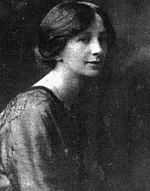Alice Perry
| Alice Perry | |
|---|---|
 | |
| Born |
Alice Jacqueline Perry 24 October 1885 Wellpark, Galway, Ireland |
| Died | 21 August 1969 (aged 83) |
| Nationality | Irish |
| Education | National University of Ireland, Galway |
| Spouse(s) | Bob Shaw |
| Parent(s) | James Perry |
|
Engineering career | |
| Engineering discipline | Civil |
Alice Jacqueline Perry (24 October 1885 – 21 August 1969) was the first woman in Ireland and the United Kingdom to graduate with a degree in engineering.[1]
Early life and education
Born in Wellpark, Galway in 1885, Alice was one of five daughters of James and Martha Perry (née Park).[2] Her father was the County Surveyor in Galway West and co-founded the Galway Electric Light Company.[3] Her uncle, John Perry, was a Fellow of the Royal Society and invented the navigational gyroscope.[4]
After graduating from the High School in Galway, she won a scholarship to study in Queen's College, Galway in 1902. Having excelled in mathematics, she changed from studying for a degree in arts to an engineering degree. She graduated with first class honours in 1906.[1][5] The family appear to have been academically gifted with two of her sisters, Molly and Nettie, also going on to third level education.[6]
Career
Following her graduation she was offered a senior postgraduate scholarship but owing to her father's death the following month, she did not take up this position.[2] In December 1906 she succeeded her father temporarily as county surveyor for Galway County Council.[2] She remained in this position for five[2] or six[1] months until a permanent appointment was made. She was an unsuccessful candidate for the permanent position and for a similar opportunity to be a surveyor in Galway East.[2] She remains the only woman to have been a County Surveyor (County Engineer) in Ireland.[1]
In 1908 she moved to London with her sisters, where she worked as a Lady Factory Inspector for the Home Office.[1] From there she moved to Glasgow, at which point she converted from Presbyterianism to Christian Science in 1915.[4] She met and married Robert (Bob) Shaw on the 30 September 1916.[2] Shaw was a soldier who died in 1917 on the Western Front.[1][2]
Later life and death
Perry retired from her inspector's position in 1921[4] and became interested in poetry, first publishing in 1922.[1] In 1923 she moved to Boston, the headquarters of Christian Science.[4] Until her death in 1969, Perry worked within the Christian Science movement as a poetry editor and practitioner,[2] publishing seven books of poetry.[1]
Legacy
An All-Ireland medal has been named in her honour, The Alice Perry Medal, with the first prizes awarded in 2014.[7]
Publications
- The children of Nazareth : and other poems (c1930)
- The morning meal and other poems (1939)
- Mary in the garden and other poems (1944)
- One thing I know and other poems (c1953)
- Women of Canaan and other poems (1961)
See also
References
- ↑ 1.0 1.1 1.2 1.3 1.4 1.5 1.6 1.7 Engineers Ireland. "Alice Perry (1885-1969)". Engineers Ireland: Realised Vision. Engineers Ireland. Retrieved 8 February 2015.
- ↑ 2.0 2.1 2.2 2.3 2.4 2.5 2.6 2.7 Irish Architectural Archive. "PERRY, ALICE JACQUELINE". Dictionary of Irish Architects 1720–1940. Irish Architectural Archive. Retrieved 8 February 2015.
- ↑ Irish Architectural Archive. "PERRY, JAMES". Dictionary of Irish Architects 1720–1940. Irish Architectural Archive. Retrieved 8 February 2015.
- ↑ 4.0 4.1 4.2 4.3 O'Connell, Claire (2009). "First in Their Field". In Mulvihill, Mary. Lab Coats and Lace. Dublin: WITS. pp. 43–45. ISBN 978-0-9531953-1-2.
- ↑ NUI Galway. "Our history". NUI Galway. NUI Galway. Retrieved 8 February 2015.
- ↑ O'Sullivan, M. D.; O'Halloran, Joe (1999). "The Centenary of Galway College". Journal of the Galway Archaeological and Historical Society 51: 24–42.
- ↑ NUI Galway. "Winners announced for the First All-Ireland Apps Competition". NUI Galway. NUI Galway. Retrieved 8 February 2015.
Further reading
- Ó hÓgartaigh, Margaret (2002). '"Am I a Lady or an Engineer?" Early Irish Female Engineers', Irish Engineers' Journal, December, pp. 48-49.